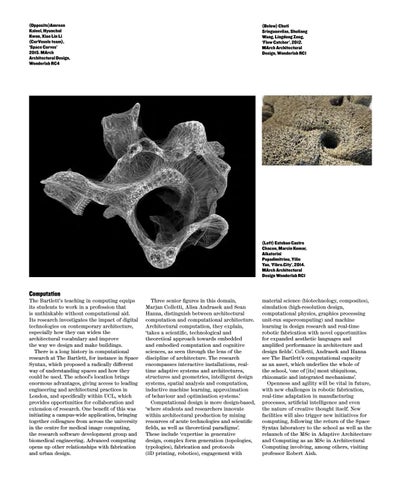(Opposite)Amreen Kaleel, Hyunchul Kwon, Xiao Lin Li (CurVoxels team), ‘Space Curves’ 2015. MArch Architectural Design, Wonderlab RC4
(Below) Chuti Sringuanvilas, Shuliang Wang, Lingdong Zeng, ‘Flow Catcher’, 2012. MArch Architectural Design, Wonderlab RC1
(Left) Esteban Castro Chacon, Marcin Komar, Aikaterini Papadimitriou, Yilin Yao, ‘Fibro.City’, 2014. MArch Architectural Design Wonderlab RC1
Computation
The Bartlett’s teaching in computing equips its students to work in a profession that is unthinkable without computational aid. Its research investigates the impact of digital technologies on contemporary architecture, especially how they can widen the architectural vocabulary and improve the way we design and make buildings. There is a long history in computational research at The Bartlett, for instance in Space Syntax, which proposed a radically different way of understanding spaces and how they could be used. The school’s location brings enormous advantages, giving access to leading engineering and architectural practices in London, and specifically within UCL, which provides opportunities for collaboration and extension of research. One benefit of this was initiating a campus-wide application, bringing together colleagues from across the university in the centre for medical image computing, the research software development group and biomedical engineering. Advanced computing opens up other relationships with fabrication and urban design.
Three senior figures in this domain, Marjan Colletti, Alisa Andrasek and Sean Hanna, distinguish between architectural computation and computational architecture. Architectural computation, they explain, ‘takes a scientific, technological and theoretical approach towards embedded and embodied computation and cognitive sciences, as seen through the lens of the discipline of architecture. The research encompasses interactive installations, realtime adaptive systems and architectures, structures and geometries, intelligent design systems, spatial analysis and computation, inductive machine learning, approximation of behaviour and optimisation systems.’ Computational design is more design-based, ‘where students and researchers innovate within architectural production by mining resources of acute technologies and scientific fields, as well as theoretical paradigms’. These include ‘expertise in generative design, complex form generation (topologies, typologies), fabrication and protocols (3D printing, robotics), engagement with
material science (biotechnology, composites), simulation (high-resolution design, computational physics, graphics processing unit-run supercomputing) and machine learning in design research and real-time robotic fabrication with novel opportunities for expanded aesthetic languages and amplified performance in architecture and design fields’. Colletti, Andrasek and Hanna see The Bartlett’s computational capacity as an asset, which underlies the whole of the school, ‘one of [its] most ubiquitous, rhizomatic and integrated mechanisms’. Openness and agility will be vital in future, with new challenges in robotic fabrication, real-time adaptation in manufacturing processes, artificial intelligence and even the nature of creative thought itself. New facilities will also trigger new initiatives for computing, following the return of the Space Syntax laboratory to the school as well as the relaunch of the MSc in Adaptive Architecture and Computing as an MSc in Architectural Computing involving, among others, visiting professor Robert Aish.
